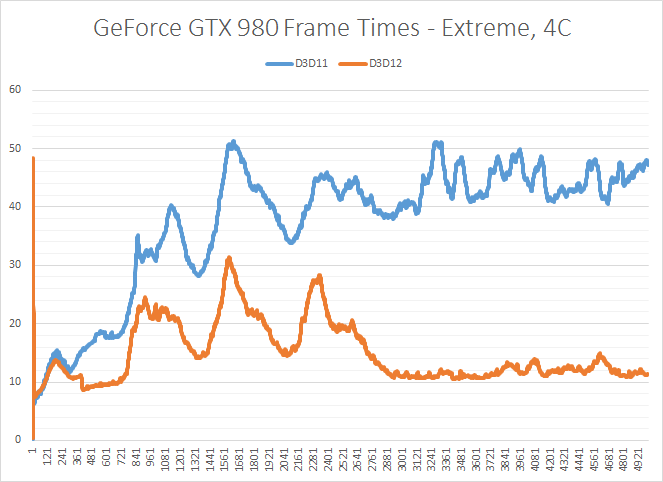The DirectX 12 Performance Preview: AMD, NVIDIA, & Star Swarm
by Ryan Smith on February 6, 2015 2:00 PM EST- Posted in
- GPUs
- AMD
- Microsoft
- NVIDIA
- DirectX 12
Frame Time Consistency & Recordings
Last, but not least, we wanted to also look at frame time consistency across Star Swarm, our two vendors, and the various APIs available to them. Next to CPU efficiency gains, one of the other touted benefits of low-level APIs like DirectX 12 is the ability for developers to better control frame time pacing due to the fact that the API and driver are doing fewer things under the hood and behind an application’s back. Inefficient memory management operations, resource allocation, and shader compiling in particular can result in unexpected and undesirable momentary drops in performance. However, while low-level APIs can improve on this aspect, it doesn’t necessarily mean high-level APIs are bad at it. So it is an important distinction between bad/good and good/better.
On a technical note, these frame times are measured within (and logged by) Star Swarm itself. So these are not “FCAT” results that are measuring the end of the pipeline, nor is that possible right now due to the lack of an overlay option for DirectX 12.
Starting with the GTX 980, we can immediately see why we can’t always write-off high-level APIs. Benchmark non-determinism aside, both DirectX 11 and DirectX 12 produce consistent frame times; one is just much, much faster than the other. Both on paper and subjectively in practice, Star Swarm has little trouble maintaining consistent frame times on the GTX 980. Even if DirectX 11 is slow, it is at least consistent.
The story is much the same for the R9 290X. DirectX 11 and DirectX 12 both produce consistent results, with neither API experiencing frame time swings. Meanwhile Mantle falls into the same category as DirectX 12, producing similarly consistent performance and frame times.
Ultimately it’s clear from these results that if DirectX 12 is going to lead to any major differences in frame time consistency, Star Swarm is not the best showcase for it. With DirectX 11 already producing consistent results, DirectX 12 has little to improve on.
Finally, along with our frame time consistency graphs, we have also recorded videos of shorter run-throughs on both the GeForce GTX 980 and Radeon R9 290X. With YouTube now supporting 60fps, these videos are frame-accurate representations of what we see when we run the Star Swarm benchmark, showing first-hand the overall frame time consistency among all configurations, and of course the massive difference in performance.












245 Comments
View All Comments
akamateau - Thursday, February 26, 2015 - link
I think that Anand has uncovered something unexpected in the data sets they have collected. The graphs showing frame time and consistency show something else besides how fast Dx12 and Mantle generate frames.Dx12 and Mantle frame times are essentially the same. The variation are only due to run-time variations inside the game simulation. When the game simulation begins there far more AI objects and draw calls compared to later in the game when many of these objects have been destroyed in the game simulation. That is the reason the frame times get faster and smooth out.
Can ANYBODY now say with a straight face that Dx12 is NOT Mantle?
Since Mantle is an AMD derived instruction set it acts as a performance benchmark between both nVidia and AMD cards and shows fairly comparable and consistant results.
However when we look at Dx11 we see that R9-290 is serious degraded by Dx11 in violation of the AMD vs Intel settlement agreement.
How both nVidia and AMD cards be essentially equivalent running Dx12 and Mantle and so far apart running Dx11? That is the question that Intel needs to answer to the FTC and the Justice Department.
This Dx11 benchmark is the smoking gun that could cost Intel BILLIONS.
Thermalzeal - Wednesday, March 4, 2015 - link
Looks like my hunch was correct. Microsoft reporting that DX12 will bump performance on Xbox One ~20%.Game_5abi - Monday, March 9, 2015 - link
so if i have to build a pc should i go for fx series due to their more cores or there is no benefit of having more than 4 cores (and should buy a i5 processor)?peevee - Friday, March 13, 2015 - link
"The bright side of all of this is that with Microsoft’s plans to offer Windows 10 as a free upgrade for Windows 7/8/8.1 users, the issue is largely rendered moot. Though DirectX 12 isn’t being backported, Windows users will instead be able to jump forward for free, so unlike Windows 8 this will not require spending money on a new OS just to gain access to the latest version of DirectX. "But this is not true, Win10 is only going to be free for a year or so and then you'll have to pay EVERY year.
Dorek - Wednesday, March 18, 2015 - link
"But this is not true, Win10 is only going to be free for a year or so and then you'll have to pay EVERY year."Wrong. Windows 10 will be free for one year, and after that you pay once to upgrade. If you get it during that one-year period, you pay 0 times.